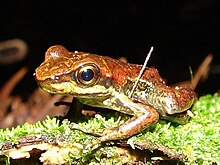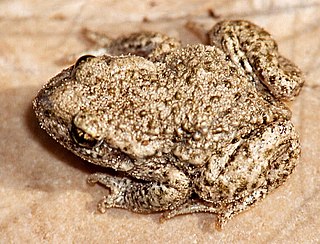
The Alytidae are a family of primitive frogs. Their common name is painted frogs or midwife toads. Most are endemic to Europe, but three species occur in northwest Africa, and a species formerly thought to be extinct is found in Israel.

The Rhinophrynidae are a family of frogs containing one extant genus, the monotypic Rhinophrynus, and a number of fossil genera. The family is sometimes known as the Mexican burrowing toads or simply burrowing toads.
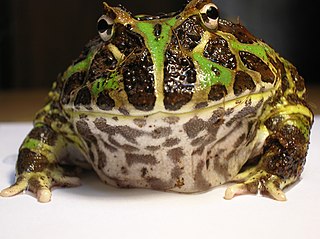
The Ceratophryidae, also known as common horned frogs, are a family of frogs found in South America. It is a relatively small family with three extant genera and 12 species. Despite the common name, not all species in the family have the horn-like projections at the eyes. They have a relatively large head with big mouth, and they are ambush predators able to consume large prey, including lizards, other frogs, and small mammals. They inhabit arid areas and are seasonal breeders, depositing many small eggs in aquatic habitats. Tadpoles are free-living and carnivorous or grazers (Chacophrys).

The Cycloramphidae are a family of frogs endemic to southeastern Brazil. This family has seen large changes in its composition. Genera that have at some point been included in the Cycloramphidae are at present placed in the Alsodidae, Hylodidae, Leptodactylidae, and Rhinodermatidae. Of these, the Alsodidae and/or Hylodidae have also been considered as subfamilies of Cycloramphidae ; the Cycloramphidae, as recognized at present, would be similar to subfamily Cycloramphinae under such system.
Phantasmarana jordanensis is a species of frog in the family Hylodidae. It is endemic to southeastern Brazil and only known from its type locality, Campos do Jordão in the São Paulo state. Its natural habitat is forest at 1,700 m (5,600 ft) asl.

Hylodes is a genus of frogs in the family Hylodidae. It might be paraphyletic with respect to Megaelosia. The genus is endemic to southeastern Brazil. They are also known as the tree toads, or more ambiguously, as torrent frogs. They are diurnal and usually inhabit shallow mountain streams.

Hylodes asper, or the Brazilian torrent frog, is a species of frogs in the family Hylodidae. It is endemic to the Rio de Janeiro and São Paulo states in southeastern Brazil. Living in a high-noise environment, the species uses "semaphoring" to supplement acoustic signalling.

Phantasmarana apuana is a species of frog in the family Hylodidae. It is endemic to Brazil. Its natural habitats are subtropical or tropical moist montane forest and rivers. It is threatened by habitat loss.
Phantasmarana bocainensis, also known as Bocaina Big tooth frog is a species of frog in the family Hylodidae. It is endemic to Brazil and only known from its type locality in the Serra da Bocaina National Park, São Paulo state.
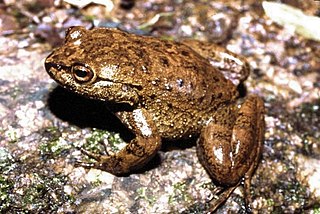
Phantasmarana boticariana is a species of frog in the family Hylodidae. It is endemic to southeastern Brazil and only known from few specimens from its type locality, Parque Estadual do Itapetinga in Atibaia, São Paulo state.
Megaelosia goeldii, also known as the Rio big-tooth frog, is a species of frog in the family Hylodidae. It is the only member of the genus Megaelosia. It is endemic to Southeast Brazil and occurs in São Paulo and Rio de Janeiro states. It is named after Émil Goeldi, a Swiss zoologist who worked in Brazil.
Phantasmarana lutzae is a species of frog in the family Hylodidae. It is endemic to Brazil and only known from its type locality in the Itatiaia National Park, Rio de Janeiro state. It is named in honor of Bertha Lutz, a Brazilian zoologist and feminist.
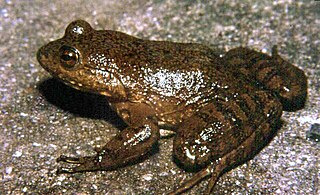
Phantasmarana massarti is a species of frog in the family Hylodidae. It is endemic to Brazil. Its natural habitats are subtropical or tropical moist lowland forest and rivers.

Phrynobatrachus is a genus of Sub-Saharan frogs that form the monogeneric family Phrynobatrachidae. Their common name is puddle frogs, dwarf puddle frogs, African puddle frogs, or African river frogs. The common name, puddle frog, refers to the fact that many species breed in temporary waterbodies such as puddles.

The Petropedetidae are a family of frogs containing three genera and 12 species. They are found in sub-Saharan tropical Africa and are sometimes known under common name African torrent frogs.

Pristimantis is a very large genus of frogs distributed in the southern Caribbean islands and in Central and South America from Honduras to northern Argentina and southern Brazil. With 596 described species, the genus had more species than any other genus of vertebrate animals. Many of these species genus are endemic to the Northwestern Andean montane forests ecoregion in north-western South America.
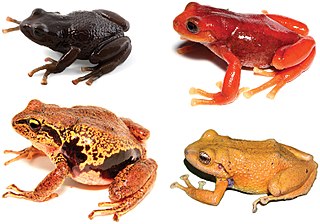
Craugastoridae, commonly known as fleshbelly frogs, is a family of New World direct-developing frogs. As delineated here, following the Amphibian Species of the World, it contains 123 species. They are found from the southern United States southwards to Central and South America.

The Brazilian gold frog, also known as Izecksohn's toad or flea-frog, is a very small species of frogs in the family Brachycephalidae. It is endemic to southeastern Brazil and is known from the central part of the state of Rio de Janeiro and from Serra das Torres in extreme southern Espírito Santo.

The Odontophrynidae are a family of frogs from southern and eastern South America. This family was first established in 1969 as the tribe Odontophrynini within the (then) very large family Leptodactylidae. Molecular phylogenetics analyses prompted the move of this group to the Cycloramphidae in 2006, before they became recognized as their own family Odontophrynidae in 2011.

Phantasmarana is a genus of frogs in the family Hylodidae. The genus is endemic to the Atlantic Forest of southeastern Brazil.
